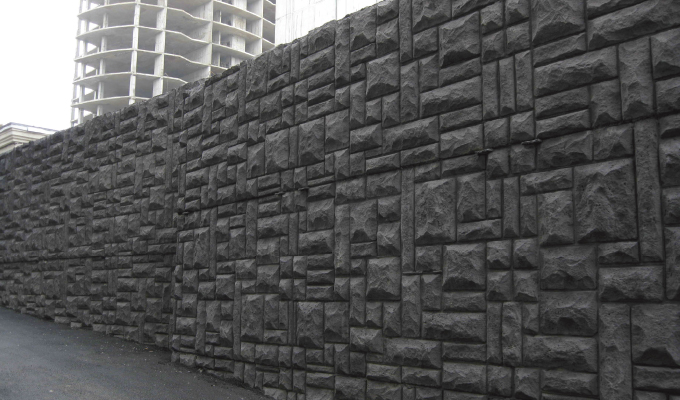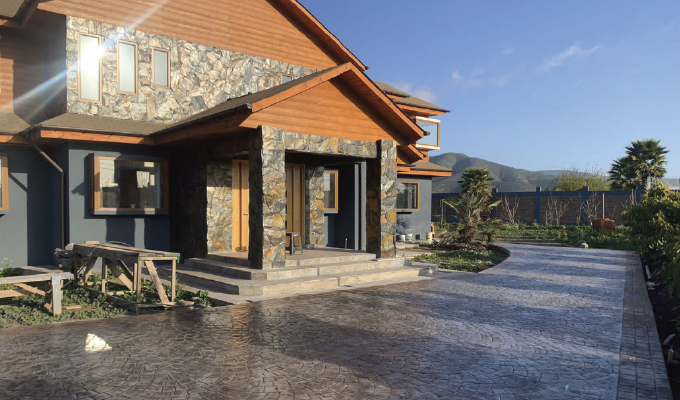Once relegated to the background of utilitarian construction, concrete is now redefining what’s possible in high-end architectural design. Boutique hotels, flagship retail stores, cultural institutions and luxury residences are embracing concrete not only for its structural integrity but for its artistic potential and environmental adaptability. As architectural trends shift toward natural materials and sustainability, concrete has emerged as a medium of choice—equal parts canvas and cornerstone.
This evolution is not incidental. Advances in concrete mix technology, surface treatments and formwork precision have transformed this material into an expressive yet durable solution. For contractors operating at the intersection of performance and luxury, understanding concrete’s expanded role is essential to meeting the evolving standards of modern design.
FROM STRUCTURAL BACKBONE TO DESIGN SHOWPIECE
Concrete’s growing popularity in the luxury sector is rooted in its ability to unify form and function. Architects and designers no longer view concrete as an unseen skeleton to be concealed beneath decorative finishes. Instead, it is specified as a finish in itself—one that defines the character of a space through its color, texture, and geometry. Monolithic stairs, cantilevered decks, sculptural facades and seamless interior planes now use concrete, transforming structural elements into visual focal points.
This shift requires contractors to adapt beyond traditional placement and finishing techniques. The precision demanded by luxury projects calls for early collaboration with design teams, thorough pre-construction planning, and mockups that validate expectations for surface quality, tone and texture. Pour sequencing, joint layout, curing conditions and finishing methods must all be carefully controlled to achieve the uniformity and refinement expected in these types of high-end environments.

AESTHETIC VERSATILITY WITH TECHNICAL PRECISION
Concrete is known for its aesthetic malleability, which aligns well with high-end applications in the luxury sector. Modern admixture technologies and mix design innovations allow for greater control over slump, setting time, workability, and finish quality, creating opportunities for a wide range of architectural expressions. Integral pigments can be used to produce consistent coloration throughout a pour, while topical stains, reactive dyes, and microtoppings offer additional layers of visual depth.
Surface finishes range from smooth-as-glass polished concrete to rugged, board-formed textures that retain the imprint of timber. Exposed aggregate surfaces can highlight the mineral composition of the mix, while treatments such as chemical densifiers and lithium-silicate sealers enhance durability and visual clarity. Specialty coatings and moisture-resistant sealants further extend performance in demanding conditions, ensuring that beauty does not come at the expense of longevity.
In luxury retail environments, for example, this aesthetic flexibility enables brands to specify tailored concrete finishes that align with their identity—from matte gray planes that evoke minimalism to reflective floors that complement high-gloss merchandising. In residential villas and estates, polished slabs, decorative overlay, and precast architectural details introduce bespoke craftsmanship into indoor and outdoor living areas. Each application demands technical fluency from the contractor—not just in mix and material selection, but in installation strategy and finish protection.
SUSTAINABILITY AS A DESIGN DRIVER
Luxury clients are increasingly aligning aesthetics with environmental stewardship. In this regard, concrete offers compelling advantages when specified and executed with sustainability in mind. High thermal mass enables passive temperature regulation, which contributes to occupant comfort and energy efficiency in both hot and cold climates. Combined with advanced envelope design and radiant systems, concrete can significantly reduce the operational carbon footprint of a building.
Equally important is the reduction of embodied carbon. Modern sustainable concrete incorporates supplementary cementitious materials such as ground granulated blast-furnace slag, fly ash, and silica fume to replace a portion of Portland cement—a major source of CO₂ emissions. Contractors are also incorporating recycled aggregates, leveraging locally sourced materials, and using curing technologies that sequester carbon dioxide during hydration. For luxury developers pursuing LEED or other green building certifications, these specifications are requirements of the job.
MASTERING THE CRAFT
A concrete installation that meets luxury-level expectations involves the alignment of multiple disciplines, such as material science, architectural intent, field conditions, and finishing craftsmanship. Temperature, humidity, and wind velocity during placement directly affect hydration, curing, and final appearance. Incorrect timing or surface preparation can also result in aesthetic inconsistencies, shrinkage cracks, or discoloration—all of which are unacceptable in premium applications.
Contractors must therefore approach each placement as both an engineering operation and a craft discipline. Surface preparation, finishing tools, joint cutting, and curing protocols should be dictated by mockup validation and coordinated with all stakeholders involved in the project. Specialty surface treatments—such as penetrating sealers, high-gloss coatings, or anti-graffiti barriers—should be selected based on the exposure conditions and long-term maintenance goals of the space.
It’s also important to note that protection of in-place concrete is just as crucial as its placement. Without proactive shielding during subsequent trades’ work, even the most beautifully placed concrete can be marred by staining, chipping, or joint damage. Contractors must establish and enforce protection protocols to preserve surface integrity until final turnover.
FUTURE OF CONCRETE IN LUXURY DESIGNS
As luxury design continues to value materials that are both authentic and enduring, concrete is poised to maintain, and even expand, its role. It offers architects a monolithic elegance unmatched by other materials, and gives contractors an opportunity to demonstrate their mastery of both form and performance. The future will likely bring even greater integration of smart concrete technologies, bio-based admixtures, and advanced surface treatments that respond dynamically to use or climate.
For contractors, embracing this trend means investing in knowledge, technique, and collaboration. It means understanding how to translate design intent into engineered execution, how to choose materials that balance environmental goals with aesthetic priorities, and how to manage variables that influence finish quality. In doing so, contractors become not just builders but partners in the creation of spaces that are structurally resilient, environmentally responsible, and aesthetically pleasing.

about the author
Rich Cofoid is a senior product and marketing manager at Euclid Chemical, a leading manufacturer of specialty concrete and masonry construction solutions. A 25-year industry veteran, Cofoid manages product marketing for the Increte line of decorative concrete products. His training sessions have been featured at several major industry events, such as World of Concrete, Concrete Décor Show, ASCC, ACI and AIA. For more, visit www.euclidchemical.com.


